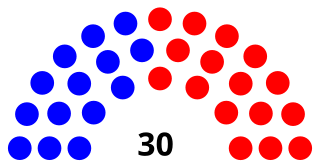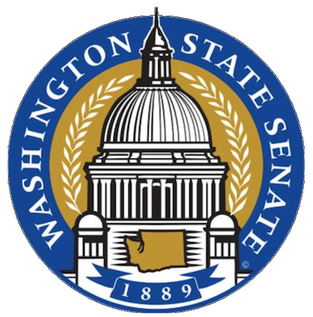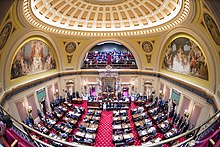
The Minnesota House of Representatives is the lower house of the U.S. state of Minnesota's legislature. It operates in conjunction with the Minnesota Senate, the state's upper house, to craft and pass legislation, which is then subject to approval by the governor of Minnesota.

The California State Legislature is a bicameral state legislature consisting of a lower house, the California State Assembly, with 80 members; and an upper house, the California State Senate, with 40 members. Both houses of the Legislature convene at the California State Capitol in Sacramento. The California state legislature is one of just ten full-time state legislatures in the United States. The houses are distinguished by the colors of the carpet and trim of each house. The Senate is distinguished by the color red and the Assembly by the color green, inspired by the United Kingdom's House of Lords and House of Commons respectively.

The Michigan Legislature is the legislature of the U.S. state of Michigan. It is organized as a bicameral body composed of an upper chamber, the Senate, and a lower chamber, the House of Representatives. Article IV of the Michigan Constitution, adopted in 1963, defines the role of the Legislature and how it is to be constituted. The chief purposes of the Legislature are to enact new laws and amend or repeal existing laws. The Legislature meets in the Capitol building in Lansing.

The Florida Legislature is the legislature of the U.S. state of Florida. It is organized as a bicameral body composed of an upper chamber, the Senate, and a lower chamber, the House of Representatives. Article III, Section 1 of the Florida Constitution, adopted in 1968, defines the role of the legislature and how it is to be constituted. The legislature is composed of 160 state legislators. The primary purpose of the legislature is to enact new laws and amend or repeal existing laws. It meets in the Florida State Capitol building in Tallahassee.

The California State Senate is the upper house of the California State Legislature, the lower house being the California State Assembly. The state senate convenes, along with the state assembly, at the California State Capitol in Sacramento.

The Michigan Senate is the upper house of the Michigan Legislature. Along with the Michigan House of Representatives, it composes the state legislature, which has powers, roles and duties defined by Article IV of the Michigan Constitution, adopted in 1963. The primary purpose of the Legislature is to enact new laws and amend or repeal existing laws.

The Connecticut State Senate is the upper house of the Connecticut General Assembly, the state legislature of the U.S. state of Connecticut. The state senate comprises 36 members, each representing a district with around 99,280 inhabitants. Senators are elected to two-year terms without term limits. The Connecticut State Senate is one of 14 state legislative upper houses whose members serve two-year terms; four-year terms are more common.

The Arizona State Senate is part of the Arizona Legislature, the state legislature of the US state of Arizona. The Senate consists of 30 members each representing an average of 219,859 constituents. Members serve two-year terms with term limits that limit Senators to a maximum four consecutive terms before requiring a one-term respite prior to running again. Members of the Republican Party are currently the majority in the Senate. There are currently 16 women serving in the Senate after Raquel Terán was appointed, making it the first time a majority of the body was composed of female members.

The Rhode Island Senate is the upper house of the Rhode Island General Assembly, the state legislature of the U.S. state of Rhode Island, the lower house being the Rhode Island House of Representatives. It is composed of 38 Senators, each of whom is elected to a two-year term. Rhode Island is one of the 14 states where its upper house serves at a two-year cycle, rather than the normal four-year term as in most states. There is no limit to the number of terms that a Senator may serve. The Rhode Island Senate meets at the Rhode Island State Capitol in Providence.

The Washington State Senate is the upper house of the Washington State Legislature. The body consists of 49 members, each representing a district with a population of nearly 160,000. The State Senate meets at the Legislative Building in Olympia.

The Vermont Senate is the upper house of the Vermont General Assembly, the state legislature of the U.S. state of Vermont. The senate consists of 30 members elected from multi-member districts. Each senator represents at least 20,300 citizens. Senators are elected to two-year terms and there is no limit to the number of terms that a senator may serve.

The Oklahoma Senate is the upper house of the two houses of the Legislature of Oklahoma, the other being the Oklahoma House of Representatives. The total number of senators is set at 48 by the Oklahoma Constitution.
The following table indicates the party of elected officials in the U.S. state of Minnesota:

Ann H. Rest is an American politician and President pro tempore of the Minnesota Senate. A member of the Minnesota Democratic–Farmer–Labor Party (DFL), she represents District 43 which includes portions of the western suburbs of Hennepin County in the Twin Cities metro area.

The eighty-first Minnesota Legislature first convened on January 5, 1999. The 67 members of the Minnesota Senate were elected during the general election of November 5, 1996, and the 134 members of the Minnesota House of Representatives were elected during the general election of November 3, 1998.

The eightieth Minnesota Legislature first convened on January 7, 1997. The 67 members of the Minnesota Senate and the 134 members of the Minnesota House of Representatives were elected during the General Election of November 5, 1996.

The seventy-seventh Minnesota Legislature first convened on January 8, 1991. The 67 members of the Minnesota Senate and the 134 members of the Minnesota House of Representatives were elected during the General Election of November 6, 1990.

The seventy-fifth Minnesota Legislature first convened on January 6, 1987. The 67 members of the Minnesota Senate and the 134 members of the Minnesota House of Representatives were elected during the General Election of November 4, 1986.

The seventy-fourth Minnesota Legislature first convened on January 8, 1985. The 67 members of the Minnesota Senate were elected during the General Election of November 2, 1982, and the 134 members of the Minnesota House of Representatives were elected during the General Election of November 6, 1984.

The 2022 Minnesota Senate election was held in the U.S. state of Minnesota on November 8, 2022, to elect members of the Senate of the 93rd Minnesota Legislature. A primary election was held in several districts on August 9, 2022. The election coincided with the election of the other house of the Legislature, the Minnesota House of Representatives, and all other statewide elections.


















